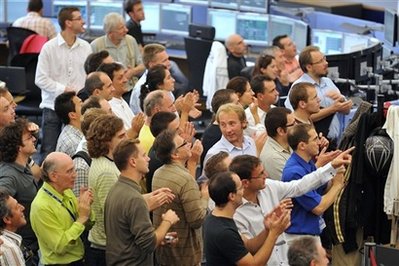The world's biggest physics experiment has succeeded in its first major test as a beam of protons was successfully fired all the way around a 17-mile tunnel beneath the Swiss-French border.
 |
|
European Organization for Nuclear Research (CERN) scientists applaud during the switch on operation of the Large Hadron Collider (LHC), the world's largest particle collider, at the CERN's control center, in Geneva, Switzerland, Wednesday, Sept. 10, 2008. [AP]
|
The protons traveled the full length Wednesday of the US$3.8 billion Large Hadron Collider that scientists hope is the next great step to understand the makeup of the universe. There were a series of trial runs.
Two white dots flashed on a computer screen indicating that the protons reached the final point of the world's largest particle collider.
Scientists hope to see what the components of atoms are made of by smashing them together.
"The beam is the size of a human hair," Paola Catapano, a spokeswoman for the host European Organization for Nuclear Research said after the protons were fired into the accelerator below the Swiss-French border at 9:32 a.m. (3:32 a.m. EDT).
|

|
|
A European Organization for Nuclear Research (CERN) scientist looks at a display at the CERN's control center, during the switch on operation of the Large Hadron Collider (LHC), the world's largest particle collider, in Geneva, Switzerland, Wednesday, Sept. 10, 2008. [AP]
|
The organization, known by its French acronym CERN, is firing the protons — a type of subatomic particle — around the tunnel in stages, several miles at a time.
Once the beam has successfully been tested in clockwise direction, CERN will send it counterclockwise. Eventually the two beams will be fired in opposite directions with the aim of smashing together protons to see how they are made.
The startup — eagerly awaited by 9,000 physicists around the world who will conduct experiments here — comes over the objections of some skeptics who fear the collisions of protons could eventually imperil the earth.